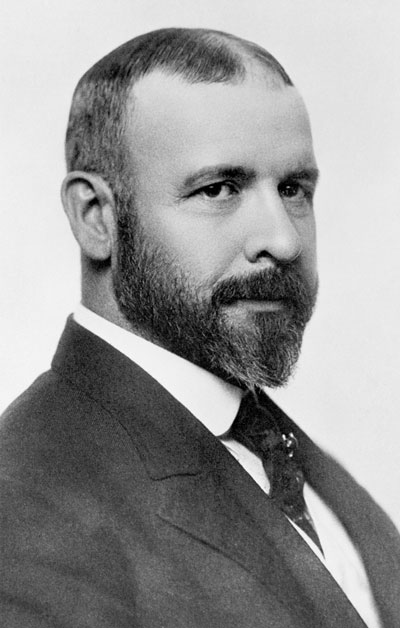
Louis Henry Sullivan (1856–1924) was born in Boston and came to Chicago after the Great Chicago Fire of 1871 to join in the rebuilding effort. Six months later, Sullivan left for Paris to study architecture at the École des Beaux-Arts, which was the leading school of architecture in the world.
In 1879, Sullivan joined the respected engineer Dankmar Adler (1844–1900), who had been practicing in Chicago since 1866. For fourteen years this relationship produced buildings distinguished by both their design and engineering innovations. Sullivan and Adler's work contributed to the development of the uniquely American building type, the skyscraper, and their partnership produced such remarkable structures as the Auditorium Building (1886–1889) in Chicago, the Wainwright Building (1890–1891) in St. Louis, the Chicago Stock Exchange (1893–1894, demolished), and the Guaranty Building (1894-1895) in Buffalo, New York. Their most renowned residential design was the commission for James Charnley on Astor Street in Chicago, Charnley-Persky House, which was completed in 1892.
Sullivan is well known for his belief that a building's function should be clearly expressed in its form and structure. Discontented with designing in the historical styles taught at the École des Beaux-Arts, Sullivan set out to create an architectural vocabulary that would reflect contemporary American culture. Due to an economic depression that started in the U.S. in 1893, which stifled new architectural commissions, Adler withdrew from the partnership in 1895 and, like Sullivan, continued to practice independently. Among Sullivan's most renowned projects from this later period are the Schlesinger and Mayer Store (now Carson, Pirie, Scott & Co., 1898–1899 and 1902–1903) in Chicago, the Bayard-Condict Building (1897) in New York, and the facade of the Gage Building (1898–1899) in Chicago. After 1900, Sullivan's work consisted mainly of exquisitely designed banks, stores, and churches located in small towns throughout the Midwest. Sullivan's protégés, most notably George Grant Elmslie and Frank Lloyd Wright, carried on his functional theories and philosophy of architectural ornament in their Prairie School designs.
In 1879, Sullivan joined the respected engineer Dankmar Adler (1844–1900), who had been practicing in Chicago since 1866. For fourteen years this relationship produced buildings distinguished by both their design and engineering innovations. Sullivan and Adler's work contributed to the development of the uniquely American building type, the skyscraper, and their partnership produced such remarkable structures as the Auditorium Building (1886–1889) in Chicago, the Wainwright Building (1890–1891) in St. Louis, the Chicago Stock Exchange (1893–1894, demolished), and the Guaranty Building (1894-1895) in Buffalo, New York. Their most renowned residential design was the commission for James Charnley on Astor Street in Chicago, Charnley-Persky House, which was completed in 1892.
Sullivan is well known for his belief that a building's function should be clearly expressed in its form and structure. Discontented with designing in the historical styles taught at the École des Beaux-Arts, Sullivan set out to create an architectural vocabulary that would reflect contemporary American culture. Due to an economic depression that started in the U.S. in 1893, which stifled new architectural commissions, Adler withdrew from the partnership in 1895 and, like Sullivan, continued to practice independently. Among Sullivan's most renowned projects from this later period are the Schlesinger and Mayer Store (now Carson, Pirie, Scott & Co., 1898–1899 and 1902–1903) in Chicago, the Bayard-Condict Building (1897) in New York, and the facade of the Gage Building (1898–1899) in Chicago. After 1900, Sullivan's work consisted mainly of exquisitely designed banks, stores, and churches located in small towns throughout the Midwest. Sullivan's protégés, most notably George Grant Elmslie and Frank Lloyd Wright, carried on his functional theories and philosophy of architectural ornament in their Prairie School designs.